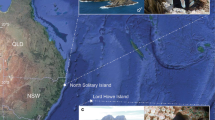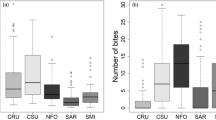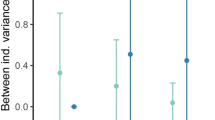Abstract
Behavioral syndromes are correlated suites of behavior, analogous to human personality traits. Most work to date has been taken from limited “snapshots” in space and time, with the implicit assumption that a behavioral syndrome is an invariant property, fixed by evolutionary constraints or adaptations. However, directional selection on two mechanistically independent traits (selective covariance) could also result in correlated behaviors. Previously, we have shown that shy/bold behavior in Southern dumpling squid (Euprymna tasmanica) across predator encounter and feeding risk contexts is genetically and phenotypically uncoupled, and hence potentially free to vary independently. Here, we collected data on shy/bold behaviors from two independent wild populations of squid in two different years to test whether behavioral correlations across these same two functional contexts vary through time and space. We detected significant influences of population, sex, and body size on the expression of boldness in squid within each functional context, and this was coupled with significant differences in relative population density and adult sex ratio. Despite these changes in behavior and demographic parameters, we found that correlations between boldness scores across the two functional contexts were largely absent in both wild populations of squid in both years. Our work suggests that some animal groups may be largely characterized by context-specific behavioral expression. A theoretical framework which conceptualizes behavioral syndromes resulting from context-specific behavioral rules may be needed to fully understand why behaviors are sometimes correlated, and why sometimes they are not.

Similar content being viewed by others
References
Alvarez D, Bell AM (2007) Sticklebacks from streams are more bold than sticklebacks from ponds. Behav Processes 76:215–217
Armbruster WS, Schwaegerle KE (1996) Causes of covariation of phenotypic traits among populations. J Evol Biol 9:261–276
Bell AM (2005) Behavioural differences between individuals and two populations of stickleback (Gasterosteus aculeatus). J Evol Biol 18:464–473
Bell AM (2007) Future directions in behavioural syndromes research. Proc R Soc Biol Sci Ser B 274:755–761
Bell AM, Sih A (2007) Exposure to predation generates personality in threespined sticklebacks (Gasterosteus aculeatus). Ecol Lett 10:828–834
Benjamini Y, Hochberg Y (1995) Controlling the false discovery rate: a practical and powerful approach to multiple testing. J Roy Stat Soc B 57:289–300
Boal JG, Hylton RA, Gonzalez SA, Hanlon RT (1999) Effects of crowding on the social behavior of cuttlefish (Sepia officinalis). Contemp Top Lab Anim Sci 38:49–55
Both C, Dingemanse NJ, Drent PJ, Tinbergen JM (2005) Pairs of extreme avian personalities have highest reproductive success. J Anim Ecol 74:667–674
Boyle PR, Boletzky Sv (1996) Cephalopod populations: definition and dynamics. Philos T Roy Soc B 351:985–1002
Brydges NM, Colegrave N, Heathcote RJP, Braithwaite VA (2008) Habitat stability and predation pressure affect temperament behaviours in populations of three-spined sticklebacks. J Anim Ecol 77:229–235
Cheverud JM (1984) Quantitative genetics and developmental constraints on evolution by natural selection. J Theor Biol 110:155–172
Coleman K, Wilson DS (1998) Shyness and boldness in pumpkinseed sunfish: individual differences are context-specific. Anim Behav 56:927–936
Dall SRX, Houston AI, McNamara JM (2004) The behavioural ecology of personality: consistent individual differences from an adaptive perspective. Ecol Lett 7:734–739
Dingemanse NJ, Réale D (2005) Natural selection and animal personality. Behaviour 142:1159–1184
Dingemanse NJ, Wright J, Kazem AJN, Thomas DK, Hickling R, Dawnay N (2007) Behavioural syndromes differ predictably between 12 populations of three-spined stickleback. J Anim Ecol 76:1128–1138
Duckworth RA (2006) Behavioral correlations across breeding contexts provide a mechanism for a cost of aggression. Behav Ecol 17:1011–1019
Endler JA (1986) Natural selection in the wild. Princeton University Press, Princeton
Epstein S (1983) Aggregation and beyond: some basic issues on the prediction of behavior. J Personal 51:360–392
Fleeson W (2004) Moving personality beyond the person-situation debate. Curr Dir Psychol Sci 13:83–87
Gosling SD (2001) From mice to men: what can we learn about personality from animal research? Psychol Bull 127:45–86
Hanlon RT (1996) Evolutionary games that squids play: fighting, courting, sneaking, and mating behaviors used for sexual selection in Loligo pealei. Biol Bull 191:309–310
Heithaus MR, Frid A, Wirsing AJ, Dill LM, Fourqurean JW, Burkholder D, Thomson J, Bejder L (2007) State-dependent risk-taking by green sea turtles mediates top-down effects of tiger shark intimidation in a marine ecosystem. J Anim Ecol 76:837–844
Huntingford FA (1976) The relationship between anti-predator behaviour and aggression among conspecifics in the three-spined stickleback. Anim Behav 24:245–260
Huntingford FA (1982) Do inter- and intraspecific aggression vary in relation to predation pressure in sticklebacks? Anim Behav 30:909–916
Hutchinson JMC, Gigerenzer G (2005) Simple heuristics and rules of thumb: where psychologists and behavioural biologists might meet. Behav Processes 69:97–124
Johnson JC, Sih A (2005) Precopulatory sexual cannibalism in fishing spiders (Dolomedes triton): a role for behavioural syndromes. Behav Ecol Sociobiol 58:390–396
Kimbell JR, McFall-Ngai MJ, Roderick GK (2002) Two genetically distinct populations of bobtail squid, Euprymna scolopes, exist on the island of O'ahu. Pac Sci 56:347–355
Lande R, Arnold SJ (1983) The measurement of selection on correlated characters. Evolution 37:1210–1226
Magnhagen C (2007) Social influence on the correlation between behaviours in young-of-the-year perch. Behav Ecol Sociobiol 61:525–531
Maxwell MR, Hanlon RT (2000) Female reproductive output in the squid Loligo pealeii: multiple egg clutches and implications for a spawning strategy. Mar Ecol Prog Ser 199:159–170
McNamara JM, Gasson CE, Houston AI (1999) Incorporating rules for responding into evolutionary games. Nature 401:368–371
Messenger JB (1977) Prey-capture and learning in the cuttlefish, Sepia. Symp Zool Soc Lond 38:347–376
Mougeot F, Redpath SM, Leckie F, Hudson PJ (2003) The effect of aggressiveness on the population dynamics of a territorial bird. Nature 421:737–739
Naud MJ, Hanlon RT, Hall KC, Shaw PW, Havenhand JN (2004) Behavioral and genetic assessment of reproductive success in a spawning aggregation of the Australian giant cuttlefish, Sepia apama. Anim Behav 67:1043–1050
Norman M, Reid A (2000) A guide to squid, cuttlefish, and octopuses of Australasia. The Gould League and CSIRO Publishing, Collingwood
Packard A (1972) Cephalopods and fish: the limits of convergence. Biol Rev 47:241–307
Quinn GP, Keough MJ (2002) Experimental design and data analysis for biologists. Cambridge University Press, Cambridge
Rands SA, Cowlishaw G, Pettifor RA, Rowcliffe JM, Johnstone RA (2003) Spontaneous emergence of leaders and followers in foraging pairs. Nature 423:432–434
Rankin DJ, Kokko H (2007) Do males matter? The role of males in population dynamics. Oikos 116:335–348
Réale D, Festa-Bianchet M (2003) Predator-induced natural selection on temperament in bighorn ewes. Anim Behav 65:463–470
Réale D, Reader SM, Sol D, Mcdougall PT, Dingemanse NJ (2007) Integrating animal temperament within ecology and evolution. Biol Rev 82:1–28
Sih A, Watters JV (2005) The mix matters: behavioural types and group dynamics in water striders. Behaviour 142:1417–1431
Sih A, Bell A, Johnson JC (2004a) Behavioral syndromes: an ecological and evolutionary overview. Trends Ecol Evol 19:373–378
Sih A, Bell AM, Johnson JC, Ziemba RE (2004b) Behavioral syndromes: an integrative overview. Q Rev Biol 79:242–277
Sinn DL, Moltschaniwskyj NA (2005) Personality traits in dumpling squid (Euprymna tasmanica): context-specific traits and their correlation with biological characteristics. J Comp Psychol 119:99–110
Sinn DL, Apiolaza LA, Moltschaniwskyj NA (2006) Heritability and fitness-related consequences of squid personality traits. J Evol Biol 19:1437–1447
Sinn DL, Gosling SD, Moltschaniwskyj NA (2008) Development of shy/bold behaviour in squid: context-specific phenotypes associated with developmental plasticity. Anim Behav 75:433–442
Stamps JA (2007) Growth-mortality tradeoffs and ‘personality traits’ in animals. Ecol Lett 10:355–363
Stapley J, Keogh JS (2005) Behavioral syndromes influence mating systems: floater pairs of a lizard have heavier offspring. Behav Ecol 16:514–520
Tabachnick BG, Fidell LS (1996) Using multivariate statistics, 3rd edn. HarperCollins, New York
van Oers K, Klunder M, Drent PJ (2005) Context dependence of personalities: risk-taking behavior in a social and a nonsocial situation. Behav Ecol 16:716–723
West-Eberhard MJ (1979) Sexual selection, social competition, and evolution. Proc Am Philos Soc 123:222–234
Wilson DS (1998) Adaptive individual differences within single populations. Philos T Roy Soc B 353:199–205
Wilson DS, Clark AB, Coleman K, Dearstyne T (1994) Shyness and boldness in humans and other animals. Trends Ecol Evol 9:442–446
Wolf M, Sander van Doorn S, Leimar O, Weissing FJ (2007) Life-history trade-offs favour the evolution of animal personalities. Nature 447:581–585
Acknowledgements
This work was conducted in partial fulfillment of the requirements for D.L. Sinn's PhD degree at the University of Tasmania. Funding was provided by a Holsworth Wildlife Research Fund grant (M0013237) and Australian International Postgraduate Research scholarship to DLS. Tom Fox-Smith, Jonothan Newman, and Colin Johnson provided essential logistical support in the field. Kees van Oers, Piet Drent, and Luc Alain-Giraldeau provided helpful discussions; Alison Bell, Jo McEvoy, and two anonymous reviewers gave constructive criticism on earlier drafts that greatly improved the final version. Experimental methods for all squid conformed to Australian law and the standards set by the University of Tasmania Animal Ethics Committee (2003).
Author information
Authors and Affiliations
Corresponding author
Additional information
Communicated by T. Bakker
Rights and permissions
About this article
Cite this article
Sinn, D.L., Moltschaniwskyj, N.A., Wapstra, E. et al. Are behavioral syndromes invariant? Spatiotemporal variation in shy/bold behavior in squid. Behav Ecol Sociobiol 64, 693–702 (2010). https://doi.org/10.1007/s00265-009-0887-2
Received:
Revised:
Accepted:
Published:
Issue Date:
DOI: https://doi.org/10.1007/s00265-009-0887-2




